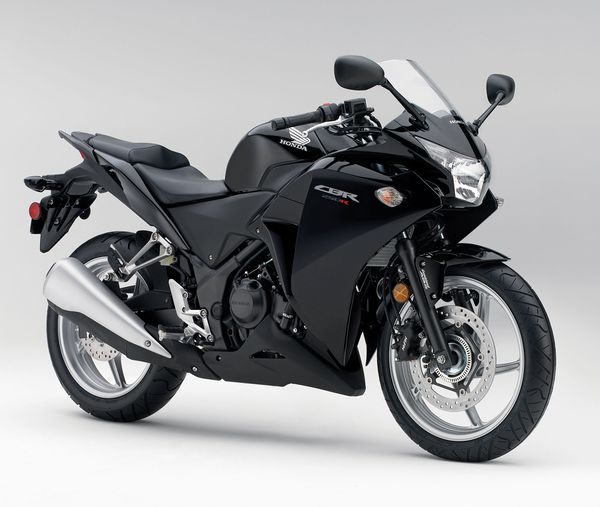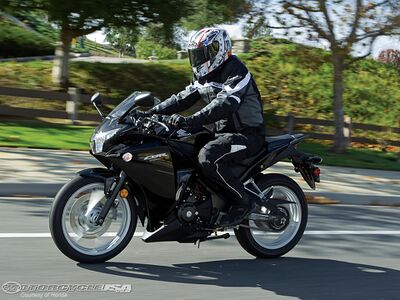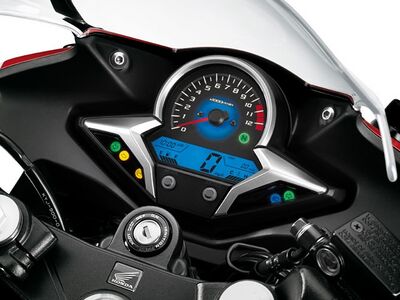Difference between revisions of "Honda CBR250R"
m |
m |
||
| (5 intermediate revisions by the same user not shown) | |||
| Line 1: | Line 1: | ||
| − | {{DISPLAYTITLE:Honda CBR250R}} | + | {{DISPLAYTITLE: Honda CBR250R}} |
| − | |||
{{#seo: | {{#seo: | ||
| − | |keywords= | + | |keywords={{PAGENAME}}, review, specs, owners manual, service manual, guide |
| + | |og:image=https://en.enduro.team/images/e/e4/2011-Honda-CBR250RABSb.jpg | ||
}} | }} | ||
__notoc__ | __notoc__ | ||
| − | [[file:2011-Honda-CBR250RABSb.jpg| | + | [[file: 2011-Honda-CBR250RABSb.jpg | 600px | center | Honda CBR250R (2011-2013)]] |
| − | + | '''Honda CBR250R''' appeared in 2011 and was intended mainly for Asian countries, but was officially supplied to many other countries around the world, including countries in Europe, North America and Oceania. | |
| + | {{Ads_top}} | ||
| − | + | '''Lineup: ''' | |
| + | * [[Honda_CBR125R | Honda CBR125R]] | ||
| + | * [[Honda_CBR150R | Honda CBR150R]] | ||
| + | * [[Honda_CBR250R | Honda CBR250R]] | ||
| + | * [[Honda_CBR300R | Honda CBR300R]] | ||
| + | * [[Honda_CBR400R | Honda CBR400R]] | ||
| + | * [[Honda_CBR500R | Honda CBR500R]] | ||
| − | + | ''' Main competitors: ''' | |
| + | * [[Kawasaki_Ninja_250R | Kawasaki Ninja 250R]] | ||
| − | + | The fashion for low-cubature (in particular, with a motor capacity of 250 cc) sporty models began with [[Kawasaki_Ninja_250R | Kawasaki Ninja 250R]], which quickly gained popularity and contributed to the rapid development of this class of motorcycles. Honda decided to offer its model to the market - the Honda CBR250R. | |
| − | + | The main feature of the Honda CBR250R is the liquid-cooled 1-cylinder engine producing 27 hp. power and 23 Nm of torque. This motor was subsequently also installed on enduro - [[Honda_CRF250L | Honda CRF250L]]. | |
| − | + | Other technical features include a steel frame, simple suspensions, disc brakes (there are versions with ABS + combined braking system), an injector, a 13-liter fuel tank, a 6-speed gearbox and from 161 kg of curb weight. | |
| − | + | 2013 was the last year of production of the Honda CBR250R model for many countries of the world, with the exception of the Asian market, after which it was replaced by an updated one - [[Honda_CBR300R | Honda CBR300R]]. The Asian version of the CBR250R has undergone a slight restyling, with an appearance identical to [[Honda_CBR300R | CBR300R]]. | |
| − | |||
| − | == | + | In 2017, Honda introduced a new model - [[Honda_CBR250RR_ (2017) | Honda CBR250RR]]. It features a 2-cylinder engine, a more expensive chassis and a modern look. |
| − | + | ||
| − | + | == Photos == | |
| − | + | <gallery mode="packed" heights=200px> | |
| − | + | File:Honda CBR250R1.jpg| | |
| − | + | File:2012-honda-cbr250r-abs-action-pic.jpg| | |
| − | + | File:Honda cbr250r ss10 640x480.jpg| | |
| − | + | </gallery> | |
| − | |||
| − | |||
| − | |||
{{Ads_feed}} | {{Ads_feed}} | ||
| − | == | + | == Specifications == |
| − | + | Specifications Honda CBR250R: | |
| − | {| class="wikitable" | + | {| class = "wikitable" |
| − | ! scope="row"| | + | ! scope = "row" | Model |
| − | |Honda CBR250R | + | | Honda CBR250R |
|- | |- | ||
| − | ! scope="row"| | + | ! scope = "row" | Motorcycle type |
| − | | | + | | sports |
|- | |- | ||
| − | ! scope="row"| | + | ! scope = "row" | Release year |
| − | |2011-2017 | + | | 2011-2017 |
|- | |- | ||
| − | ! scope="row"| | + | ! scope = "row" | Frame |
| − | | | + | | steel diagonal |
|- | |- | ||
| − | ! scope="row"| | + | ! scope = "row" | Engine type |
| − | |1- | + | | 1-cylinder, 4-stroke |
|- | |- | ||
| − | ! scope="row"| | + | ! scope = "row" | Working volume |
| − | |259 | + | | 259.6 cm³ |
|- | |- | ||
| − | ! scope="row"| | + | ! scope = "row" | Bore / stroke |
| − | |76 | + | | 76.0 x 55.0 mm |
|- | |- | ||
| − | ! scope="row"| | + | ! scope = "row" | Compression ratio |
| − | |10 | + | | 10.7: 1 |
|- | |- | ||
| − | ! scope="row"| | + | ! scope = "row" | Cooling |
| − | | | + | | liquid |
|- | |- | ||
| − | ! scope="row"| | + | ! scope = "row" | Number of valves per cylinder |
| − | |DOHC, 4 | + | | DOHC, 4 valves |
|- | |- | ||
| − | ! scope="row"| | + | ! scope = "row" | Fuel supply system |
| − | | | + | | injector, PGM-Fi x1 38 mm |
|- | |- | ||
| − | ! scope="row"| | + | ! scope = "row" | Ignition type |
| − | | | + | | fully transistor |
|- | |- | ||
| − | ! scope="row"| | + | ! scope = "row" | Maximum power |
| − | |27 | + | | 27.0 h.p. (20.0 kW) @ 8500 rpm - CBR250R (2011-2013) |
| − | 29 | + | 29.0 h.p. (21.0 kW) @ 9000 rpm - CBR250R (2015-2017) |
|- | |- | ||
| − | ! scope="row"| | + | ! scope = "row" | Maximum torque |
| − | |23 | + | | 23.0 Nm (2.4 kgm) @ 7000 rpm - CBR250R (2011-2013) |
| − | 23 | + | 23.0 Nm (2.4 kgm) @ 7500 rpm - CBR250R (2015-2017) |
|- | |- | ||
| − | ! scope="row"| | + | ! scope = "row" | Gearbox |
| − | |6- | + | | 6-speed |
|- | |- | ||
| − | ! scope="row"| | + | ! scope = "row" | Drive type |
| − | | | + | | chain |
|- | |- | ||
| − | ! scope="row"| | + | ! scope = "row" | Front tire size |
| − | |110/70-17M/C (54S) | + | | 110 / 70-17M / C (54S) |
|- | |- | ||
| − | ! scope="row"| | + | ! scope = "row" | Rear tire size |
| − | |140/70-17M/C (66S) | + | | 140 / 70-17M / C (66S) |
|- | |- | ||
| − | ! scope="row"| | + | ! scope = "row" | Front brakes |
| − | |1 | + | | 1 disc 296 mm, 2-piston caliper (CBR250RA - Combined ABS, 3-piston caliper) |
|- | |- | ||
| − | ! scope="row"| | + | ! scope = "row" | Rear brakes |
| − | |1 | + | | 1 disc 220 mm, 1-piston caliper (CBR250RA - Combined ABS) |
|- | |- | ||
| − | ! scope="row"| | + | ! scope = "row" | Front suspension |
| − | | | + | | 37mm Telescopic Fork (Fixed), 118mm Travel |
|- | |- | ||
| − | ! scope="row"| | + | ! scope = "row" | Rear suspension |
| − | | | + | | linkage Pro-Link with monoshock (adjustable preload), stroke - 104 mm |
|- | |- | ||
| − | ! scope="row"| | + | ! scope = "row" | Length |
| − | |2035 | + | | 2035 mm |
|- | |- | ||
| − | ! scope="row"| | + | ! scope = "row" | Width |
| − | |720 | + | | 720 mm |
|- | |- | ||
| − | ! scope="row"| | + | ! scope = "row" | Height |
| − | |1125 | + | | 1125 mm |
|- | |- | ||
| − | ! scope="row"| | + | ! scope = "row" | Wheelbase |
| − | |1370 | + | | 1370 mm |
|- | |- | ||
| − | ! scope="row"| | + | ! scope = "row" | Minimum ground clearance |
| − | |145 | + | | 145 mm |
|- | |- | ||
| − | ! scope="row"| | + | ! scope = "row" | Saddle height |
| − | |780 | + | | 780 mm |
|- | |- | ||
| − | ! scope="row"| | + | ! scope = "row" | Acceleration to 100 km / h |
| − | |8 | + | | 8.79 sec |
|- | |- | ||
| − | ! scope="row"| | + | ! scope = "row" | Maximum speed |
| − | |147 | + | | 147 km / h |
|- | |- | ||
| − | ! scope="row"| | + | ! scope = "row" | Fuel tank capacity |
| − | |13 | + | | 13.0 l |
|- | |- | ||
| − | ! scope="row"| | + | ! scope = "row" | Motorcycle weight (curb) |
| − | |162 | + | | 162 kg - CBR250R (2011-2013) |
| − | 166 | + | 166 kg - CBR250RA (ABS) (2011-2013) |
| − | 161 | + | 161 kg - CBR250R (2015-2017) |
| − | 164 | + | 164 kg - CBR250RA (ABS) (2015-2017) |
|- | |- | ||
|} | |} | ||
| − | == | + | == Documentation == |
| − | + | [[Category:Motorcycles]] | |
| − | + | * [[Honda_CBR250R:_manuals|Honda CBR250R]] | |
| − | |||
| − | |||
| − | |||
| − | |||
| − | |||
| − | * [[Honda_CBR250R:_manuals|Honda CBR250R | ||
== == | == == | ||
{{Ads_recomended}} | {{Ads_recomended}} | ||
Latest revision as of 12:25, 27 June 2023
Honda CBR250R appeared in 2011 and was intended mainly for Asian countries, but was officially supplied to many other countries around the world, including countries in Europe, North America and Oceania.
Lineup:
Main competitors:
The fashion for low-cubature (in particular, with a motor capacity of 250 cc) sporty models began with Kawasaki Ninja 250R, which quickly gained popularity and contributed to the rapid development of this class of motorcycles. Honda decided to offer its model to the market - the Honda CBR250R.
The main feature of the Honda CBR250R is the liquid-cooled 1-cylinder engine producing 27 hp. power and 23 Nm of torque. This motor was subsequently also installed on enduro - Honda CRF250L.
Other technical features include a steel frame, simple suspensions, disc brakes (there are versions with ABS + combined braking system), an injector, a 13-liter fuel tank, a 6-speed gearbox and from 161 kg of curb weight.
2013 was the last year of production of the Honda CBR250R model for many countries of the world, with the exception of the Asian market, after which it was replaced by an updated one - Honda CBR300R. The Asian version of the CBR250R has undergone a slight restyling, with an appearance identical to CBR300R.
In 2017, Honda introduced a new model - Honda CBR250RR. It features a 2-cylinder engine, a more expensive chassis and a modern look.
Photos
Specifications
Specifications Honda CBR250R:
| Model | Honda CBR250R |
|---|---|
| Motorcycle type | sports |
| Release year | 2011-2017 |
| Frame | steel diagonal |
| Engine type | 1-cylinder, 4-stroke |
| Working volume | 259.6 cm³ |
| Bore / stroke | 76.0 x 55.0 mm |
| Compression ratio | 10.7: 1 |
| Cooling | liquid |
| Number of valves per cylinder | DOHC, 4 valves |
| Fuel supply system | injector, PGM-Fi x1 38 mm |
| Ignition type | fully transistor |
| Maximum power | 27.0 h.p. (20.0 kW) @ 8500 rpm - CBR250R (2011-2013)
29.0 h.p. (21.0 kW) @ 9000 rpm - CBR250R (2015-2017) |
| Maximum torque | 23.0 Nm (2.4 kgm) @ 7000 rpm - CBR250R (2011-2013)
23.0 Nm (2.4 kgm) @ 7500 rpm - CBR250R (2015-2017) |
| Gearbox | 6-speed |
| Drive type | chain |
| Front tire size | 110 / 70-17M / C (54S) |
| Rear tire size | 140 / 70-17M / C (66S) |
| Front brakes | 1 disc 296 mm, 2-piston caliper (CBR250RA - Combined ABS, 3-piston caliper) |
| Rear brakes | 1 disc 220 mm, 1-piston caliper (CBR250RA - Combined ABS) |
| Front suspension | 37mm Telescopic Fork (Fixed), 118mm Travel |
| Rear suspension | linkage Pro-Link with monoshock (adjustable preload), stroke - 104 mm |
| Length | 2035 mm |
| Width | 720 mm |
| Height | 1125 mm |
| Wheelbase | 1370 mm |
| Minimum ground clearance | 145 mm |
| Saddle height | 780 mm |
| Acceleration to 100 km / h | 8.79 sec |
| Maximum speed | 147 km / h |
| Fuel tank capacity | 13.0 l |
| Motorcycle weight (curb) | 162 kg - CBR250R (2011-2013)
166 kg - CBR250RA (ABS) (2011-2013) 161 kg - CBR250R (2015-2017) 164 kg - CBR250RA (ABS) (2015-2017) |
Documentation



